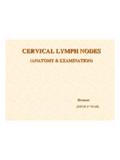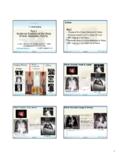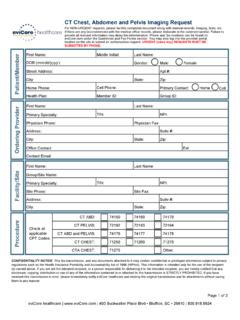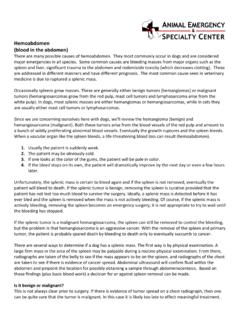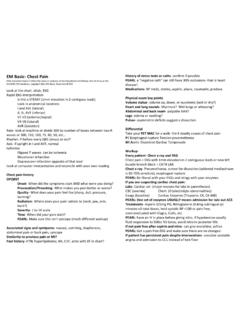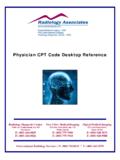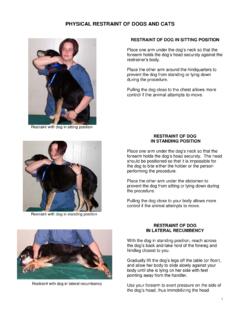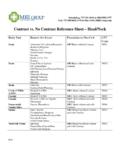Transcription of Chest Tubes: From Indications to Removal
1 Chest tubes : From Indication to RemovalObjectives Review respiratory anatomy and physiology. Discuss assessment of the pulmonary system. Recognize Indications for Chest tube placement. Explain nursing responsibilities with Chest tube insertion, daily care, trouble shooting, and of the Respiratory TractUpper Respiratory Tract:NoseMouthNasopharynxOropharynxLary ngopharynxLarynxLower Respiratory Tract:TracheaPrimary Bronchi Lobar BronchiSegmental BronchiMusculoskeletal Anatomy of RespirationThoracic Cage:ManubriumRibsSternumVertebral ColumnXiphoid ProcessMuscles of Respiration:DiaphragmExternal IntercostalsAccessory Muscles:Abdominal RectusInternal IntercostalsPectorals Posterior Trapezius SternocleidomastoidInspiration Active process Thoracic cage expands Diaphragm contracts and lengthens thus lifting ribs upward and outward and displaces abdominal contents downward External intercostal muscles contract and pulls ribcage upward and increases width Net effect of is twofold.
2 Intrathoracic volume increases and pressures are lowered Pressure gradient causes air to move into lungsExpiration Relatively passive process Diaphragm moves upward and external intercostals relax, size of thoracic cage decreases Accessory muscles contract, ribcage moves upward, abdominal contents rise Pressures become slightly positive and air flows out of the lungsA Little Physiology Human breathes 12-15/minute About 500 milliliters per breath 6-8 liters/ minute Air mixes in alveoli Oxygen enters blood in pulmonary capillaries Carbon dioxide enters the alveoli 250 milliliters of oxygen enters while 200 milliliters of carbon dioxide departs 250 volatile substances identified in human breathAssessment of Respiratory System Presenting illness Past medical history Physical assessment:InspectionPalpationPercussion Auscultation of breath sounds and quality of voiceInspectionRelaxed, effortless, occasional sighing, eupnea, pink, moist mucous membranes, trachea midline and straight, symmetrical Chest , scapulae on same horizontal plane, alert and oriented, inspiration to expiration ratio 1:2, angulation at base of nail and finger, diaphragmatic (male) vs thoracic (female) breathing, spine straight, sitting or reclined without difficultyPalpation Presence and quality of pulses Skin smooth, warm, and dry Capillary refill less than 2 seconds Mild vibration on Chest wall during vocalization Spine and ribs non-tender symmetrical lateral Chest expansion (3-8 cm) Percussion Resonance is easily heard.
3 Equal quality bilaterally. Low-pitched and hollow sounding . Diaphragmatic excursion 3-5 cm and hemi-diaphragm moves 3-6 : Heard around trachea and larynx Harsh, hollow, tubular quality Loud, high-pitchedBronchovesicular: Heard around scapulae, upper sternum in first and second intercostal spacesVesicular: Heard over peripheral lung fields Low, soft rustling soundsAdventitious Lung Sounds Crackles: Fine, high-pitched/coarse low-pitched, short, discontinuous, commonly heard during inspiration, indicative of air passing though fluid in small airways Rhonchi: Low-pitched, continuous snoring sound, commonly heard during expiration, potentially large airway obstructed by fluid Wheezes: High-pitched whistling sounds, heard in expiration and inspiration, indicates air passing through narrow airways Pleural Friction Rub.
4 Scratching, grating, rubbing, creaking best heard at base of lung during end-expiration, and indicates inflamed pleura.\The Patient in Respiratory Distress Abdominal/Accessory muscles use. Abnormal breath sounds Asymmetrical Chest wall motion Decreased oxygen saturation Decreased urine output ECG changes Hyper/hypoventilation Jugular venous distention Nasal flaring Restlessness/confusion/agitation Shortness of breath Skin color changes Tachycardia and hypertension Tracheal shiftNormal Chest Roentgenogram (X-ray)Based on systematic evaluation: Soft tissues of neck, shoulders, breasts, axillae, diaphragms, and upper abdomen Skeletal structures such as clavicles, ribs, vertebrae, scapulae, and sternum Trachea, bronchi, pleural spaces, and lung parenchyma tubes , lines, and monitoring devicesComparison of Chest Radiographs (Pneumothorax)Normal Chest X-raySimple PneumothoraxCollapsed lungComparison of Chest Radiographs (Pneumothorax)Normal Chest X-raySimple PneumothoraxDeep Sulcus SignComparison of Chest Radiographs (Pneumothorax)Normal Chest X-rayTension PneumothoraxNote the mediastinal shift !
5 !Comparison of Chest Radiographs (Hemothorax)Normal Chest X-ray Right HemothoraxPatient Supine blood layers inferiorlyComparison of Chest Radiographs (Hemothorax)Normal Chest X-ray Right HemothoraxPatient Prone blood layers of Chest Radiographs (Pleural Effusion)A pleural effusion and a hemothorax look the same, depending on the position of the of Chest Radiographs (Hemopneumothorax)Comparison of Chest Radiographs What do you see?Normal Chest X-ray Well?Comparison of Chest Radiographs (?????)NGT floating freely in the left for a ruptured left hemidiaphragm !!A Little History Hippocrates (470-500 BC) described techniques to cannulate the pleural space Hillier (1867) opened empyema under water Playfair (1872) introduced water seal Hewett (1876) incorporated use of continuous Chest drainage system with water seal WWI Army formed Empyema Commission WWII saw use in thoracotomies Korean War saw use in traumaIndication for Chest Tube Placement Pneumothorax Hemothorax Symptomatic pleural effusion Empyema Complicated parapneumonic effusion Chylothorax Sclerosis of recurrent malignant effusionsChest tubes French sizing refers to the diameter of the tube in millimeters from 8-40 Fr Tube is sterile, flexible, nonthrombogenic composed of vinyl or silicone Typically packaged with aluminum trocar Measures 20 inches in length (50 cm)
6 Proximal end is fenestrated Indications and patient size dictates size Pneumothorax: 20-24 Fr Fluid: 28 Fr Average adult/teen male: 28-32 Fr Average adult/teen female: 28 FrChest Tube InsertionInsertion site is at the 6th intercostal space, anterior axillary lineConsent is obtained and the procedure is explainedPretreatment with analgesia, oxygen, and/or anxiolyticsPatient placed supine and arm raised over head . Chest Tube InsertionChest is surgically prepared in normal sterile fashionLocal anesthetic is infiltrated into skin, subcutaneous tissue, Chest wall, intercostal muscle, periosteum, and parietal pleuraChest Tube Insertion1-inch incision is made directly over the ribChest Tube InsertionA hemostat is used to spread the subcutaneous tissues down to the rib. It is then used to pop into the pleural space just above the ribChest Tube InsertionAfter the pleural space has been penetrated, a hemostat is used to grasp the tip of the Chest tube and guide it through the subcutaneous tunnel and into the Chest cavityChest Tube InsertionThe incision is closed and the Chest tube is tied in placeCommon Complications of Chest Tube Insertion Allergic reaction Bronchopleural fistula Cardiac injury Hemorrhage Hepatic injury Infection Intercostal nerve, artery, or vein injury Lung laceration Re-expansion pulmonary edema Splenic injury Subcutaneous emphysema Nursing Responsibilities Conduct routine patient assessment Frequently assess the insertion site, tube, tubing, and drainage unit Monitor amount, color.
7 And consistency of the drainage Encourage positioning with head of bed up to 30 degrees Educate about the benefits of coughing, deep breathing, use of the incentive spirometer, and/or flutter valve every two hours Advocate ambulation and position changesAmount, Color, and Consistency Sudden drainage increases could be indicative of hemorrhage Changes in drainage from serosanguinous to red could indicate hemorrhage Consistency changes from thin, clear fluid to milky could be evidence of evolving infection Decreased drainage may be a sign of tube displacement, kinked tubing, or a clot may be obstructing the lumen of the tubeHow Does a Chest Tube Function?1) Collection Bottle: collects fluid and debris delivered by Chest tube. Connected to water seal chamber2) Water Seal Bottle: One way valve for air to escape from the pleural space, measures negative pressure in Chest , and determines degree of air leak3) Suction Control Bottle.
8 Volume of water determines amount of negative pressure in pleural spaceGoal is to remove fluid or air from the pleural space, prevent re- accumulation, and allow for lung re- Atmospheric vent Collection chamber Filtered high negativity relief valve High negativity float valve Patent air leak meter Positive pressure relief valve Self-sealing diaphragm Suction control pressure scale Suction tubing Water seal pressure scaleSetting Up the Pleur-Evac Fill water seal chamber Connect to Chest tube Connect to suction Fill suction chamber Turn on suctionAssessing the Water Seal Pressure Scale Tidaling is the rhythmic fluctuations in the water seal chamber that correspond to respirations If bubbling is seen, this indicates an air leak. Assess from insertion site down to the Chest drainage system Negative pressure in the water seal pressure scale indicates negative pressure in the pleural space Under filled chamber could result in pneumothorax as there is no water seal Over filled chamber could increase the need for more pressure to actually drain the Chest Assessing Air LeaksWhat is it?
9 Bubbling seen in the water seal pressure scale. Usually will have some rise and fall with each breath, but constant bubbling is a clue that there could be a problem in: Chest tube drainage system Poorly positioned Chest tube Injury to bronchus/esophagus Continued air leak in the lungAssessing Air LeaksTo help determine the location of an air leak, the Chest tube may be clamped near the Chest wall:If the air leak disappears, then the leak is comingfrom the patient ( persistent lung injury)If the air leak continues, the leak is coming from a location distal to the hole in Chest tube, loose connection, leak in the tubing, faulty pleuravac system, t forget to release the clamp!!!Bad Things Happen to Good People . Chest tube gets dislodged: If you hear air leaking, cover site with three sided dressing.
10 If no air is heard, cover with sterile dressing and notify the physician. Chest drainage unit breaks: change the unit, assess, and notify physician In emergent situations, tubing could be placed in sterile water/saline at a depth of 2-4 cm to re-establish the water sealWhen is it Time to Come Out? When indication for insertion is no longer present ( resolution of pneumothorax, hemothorax, ) No air leak evident the day before considering Chest tube Removal Drainage less than 50cc/8 hours or 150cc/day Patient able to tolerate Chest drainage system being brought to water seal from suction Chest x-ray shows complete re-expansion of the lungDiscontinuing the Chest Tube Procedure is explained and appropriate pre-medication is performed Assumes supine position with arm above head on side of tube Chest drainage unit brought to water seal and the dressing is removed Either upon deep inspiration (if patient is intubated)or exhalation (if patient is on CPAP or not intubated)
